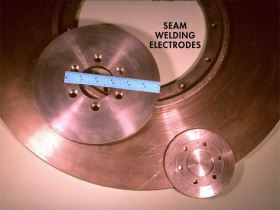Seam welding will generally use the same alloys as spot welding. The higher conductivity lower strength workpieces will be welded using Class 2 and the stronger work pieces will use Class 3. As in the case of spot RWMA Class 2 is the most used product for seam welding. Most seam welding wheels are ideally cross forged to break up the original cast billet grain structure. There are two schools of thought on this forging. One is to forge blanks after being sliced from a cast billet. The other is to forge the cast billet then slice the blank. Both processes break up cast structure but to different degrees. The individual forged blank process will inherently cost more since you forge each blank individually. If you have a difficult heavy wheel wear application you might want to consider paying the extra dollars.
Some wheels are made by cutting ends off rod and others by cutting out of plate. Neither of these products would be expected to hold up in heavy duty applications.

Reference:AWS C1.1 Recommended Practices for Resistance Welding
RWMA Manual Section 4

